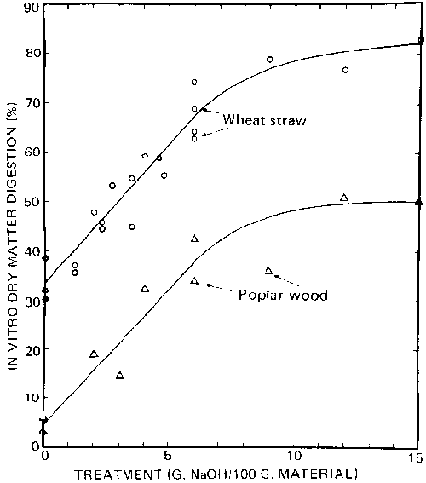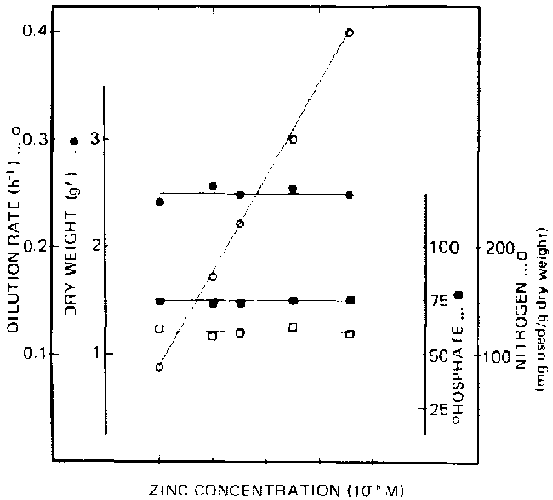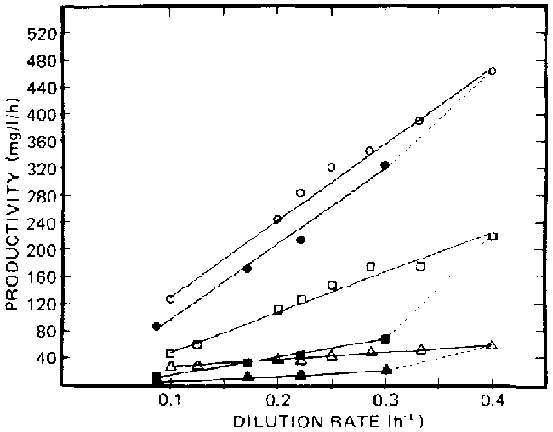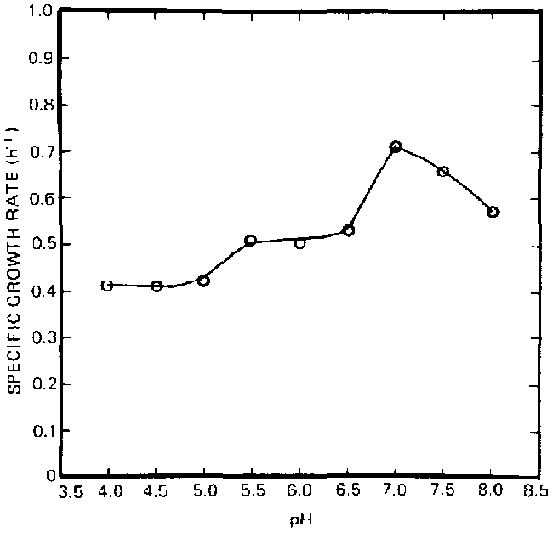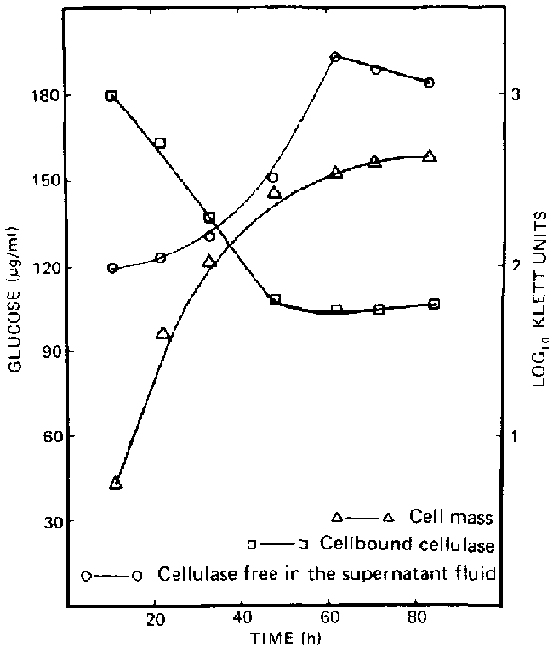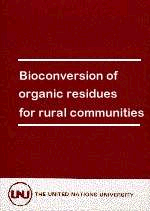
Bioconversion of Organic Residues for Rural Communities (UNU, 1979, 178 p.)[edit | edit source]
Production of single-cell protein from cellulose[edit | edit source]
V.R. Srinivasan
Department of Microbiology, Louisiana State University, Baton Rouge, Louisiana, USA
Introduction[edit | edit source]
Production of food, fuel, and chemicals is one of the primary requirements for the development and welfare of a society. During the past decade, the pattern of agricultural production has shifted in the world in such a manner that most of the countries around the world are not self-sufficient in their food production. The present shortage and impending depletion of fossil fuels place certain constraints on increasing agricultural productivity even in industrially developed countries. Further constraints are placed on the developing countries in meeting their food needs because of low productivity in agriculture and a steady increase in population. The race to catch up with the need for food by modernization of agriculture is steadily being lost to the burgeoning populations in several areas of the world. Thus, the necessity for exploring unconventional, non-agricultural means of food production, especially of proteins, cannot be over-emphasized. Production of microbial proteins or bioproteins by fermentation of agricultural waste products is one of the most promising approaches for increasing the availability of proteins in the world.
During the past several years, we have concentrated our efforts in developing fermentation of cellulose by micro-organisms. Cellulose is the major constituent of all agricultural wastes. Also, as a renewable resource, it is plentifully available for utilization as a substrate for fermentation of non-wood plant fibrous raw materials. The potential availability of such natural raw material is presented in Table 1 (1).
TABLE 1. Estimated Availability of Specific Non-Wood Plant Fibrous Raw Materials
| Raw materials | 1,000 metric tons |
| Sugar-cane bagasse | 55,000 |
| Different straws (wheat, rice, oat, etc.) | 88,500 |
| (Bast fibres kute, kenaf, etc) | 6,099 |
| Leaf fibres (sisal, abaca) | 904 |
| Reeds | 30,000 |
| Bamboo | 30,000 |
| Papyrus | 5.000 |
| Esparto grass | 500 |
| Sabai grass | 200 |
| Cotton fibre | 13,500 |
| Total | 229,703 |
Source: Virkola (1).
Cellulose, however, does not occur in pure form. It is always associated with lignin and hemicelluloses. Thus, naturally occurring cellulose is not readily susceptible to microbial attack. Hence, it is essential that the cellulose be previously treated, by either physical or chemical methods, to facilitate the growth of micro-organisms (2).
Reduction of particle size of ligno-cellulosics leads to an increase in their susceptibility to microbial fermentation. This has been accomplished with both wet and dry raw materials. Either very fine grinding or ball milling has been the usual procedure. These methods require a high amount of energy, and hence add considerable cost to the overall production of biomass. Other physical methods for particle size reduction make use of sonic energy, cryogenic grinding, or extremely rapid depressurization with steam to cause multiple fractures within the cell walls of natural fibres, thereby increasing the total surface area. Some of the possible chemical methods of treatment include: (i) treatment with gaseous sulphur dioxide; (ii) alcoholysis of lignin with methanol or ethanol containing small amounts of hydrochloric or sulphuric acids; (iii) degradation of lignin under mild acid conditions; (iv) extraction of lignin by organic solvents such as acetone, dioxane, or others in the presence of mild acids, and (v) treatment with sodium hydroxide or ammonia to swell the cellulose fibres and solubilize lignin and hemicelluloses.
Alkali treatment has been the method of choice in all our investigations of cellulose fermentation. In this process, cellulose is steeped in 5 - 10 vol of 1 N sodium hydroxide and heated for 15 - 30 minutes at 100 - 120 C. In order to illustrate the efficacy of alkali treatment, some of the results obtained by Wilson and Pigden (3) on the in vitro digestion of wheat straw and poplar wood are presented in Figure 1.
Figure. 1. Effect of Sodium Hydroxide Pre-Treatment on the In Vitro Digestion of Wheat Straw and Poplar Wood
There are only a few organisms that can attack "native" cellulose. However, when cellulose is treated or modified before micro-organisms are introduced, the choice of available organisms increases greatly. Table 2 presents a few selected organisms that have been investigated in the biodegradation of ligno-cellulosics (4 8).
Peitersen (4).** Chahal and Wang (5).*** Eriksson and Larsson (6).+ Daugulis and Bone (7).++ Humphrey et al. (8).
This paper describes the "state of the art" in our laboratory investigations on the biodegradation of cellulose by microorganisms, leading to the production of single-cell protein.
Experimental results[edit | edit source]
The investigations carried out to date are as follows:
a. studies on bacterial fermentation of cellulose using Cellulomonas as the main organism;
b. Aspergillus terreus as SCP from cellulose;
c. growth of yeast on cellulosic substrates.
Studies on Bacterial Degradation of Cellulose
The primary objective in all earlier investigations was to optimize the growth environments of Cellulomonas in such a manner as to increase the rate of degradation of alkalis treated cellulose, and thereby increase the productivity (biomass produced per unit volume per unit time). The problem was investigated in three different sets of experiments: (i) symbiotic growth of Cellulomonas with organisms having the ability to grow on cellobiose as the sole carbon source; (ii) mutation of the parent strain of Cellulomonas by chemical mutagens, and isolation of strains with less fastidious requirements for growth, and (iii) studies on the physiology of the organism in continuous culture with a view towards making the best use of the constituents in the nutrient medium to promote maximum growth. Based upon observations from studies of continuous culture, a simple technique known as gradient feed was developed for growing cells at high densities in batch cultures in laboratory fermenters (9). The experimental results obtained so far from batch fermentations of Cellulomonas are summarized in Table 3.
All cellulose substrates were treated with NaOH** Fermentations were carried out at controlled pH at 6.8 in New Brunswick 7-litre fermenter at 35 C.
Investigations on continuous cultivation of Cellulomonas were conducted with glucose as the carbon source. Although our main interest is in growth of the organism on cellulose, glucose was initially chosen as the substrate in order to understand the basic physiology of the organism, which is more easily observed using glucose. During these experiments, we noted that trace elements in the medium play an important role in regulating the growth rate of the organism. The minimum concentration of Zn(++) ion required for maintenance of steady states at different dilution rates was examined. Moreover, the macromolecular composition of the organism at different dilution rates was determined (Figures 2, 3). As seen in Figure 3, RNA content in the cell is lower in Zn(++). This is indeed an interesting observation, for this may provide a method of decreasing the total nucleic acid content of the cell.
Figure. 2. Variation of the Dilution Rates Dependent upon the Minimum Concentrations of Zn(++) in the Influent for the Maintenance of Constant Biomass at Steady State during Cultivation of Cellulomonas in a Chemostat Dilution Rate
Figure. 3. Macromolecular Composition of Cells of Cellulomonas in a Chemostat under Conditions of Minimum and Excess Amounts of Zn(++) in the Nutrient Feed
Studies of Cellulose Degradation by Asporgillus terreus
Microfungi have attracted but little attention as single-cell proteins for two reasons: (i) fungi are supposedly slow-growing, and (ii) they may produce mycotoxins during cultivation. However, they have several advantages. They can be grown at low pHs and thereby minimize the problem of contamination. Because of the size of the organisms, they may be more economically harvested out of the fermentation menstruum. A number of fungi have growth rates exceeding 0.20 hr(-1) sufficiently fast enough for consideration for the production of SCP (10). Gray has shown that filamentous fungi have been used widely by man either directly or indirectly for food (11). Mycotoxins are produced only by a few organisms in stationary phase as secondary metabolites, and they are synthesized only at a particular stage in the life cycle of the organism. Hence, even in fermentations with such organisms, it may be possible to inhibit the production of toxins by growing the organism at fast growth rates. We have, therefore, attempted to develop a fungal fermentation on cellulose.
We have screened for several fungi and isolated a cellulolytic strain of Aspergillus terreus for further study. Preliminary experiments showed that the organism has the potential to grow on a variety of carbon substrates such as glucose, lactose, cellobiose, and starch as well as on cellulose. Although the germination of the spores required additional growth factors from yeast extract, mycelial growth occurred on carbon substrates in a simple minerals medium. The organism exhibited growth over a wide range of pHs (3.5 to 7.0) and temperatures (30� to 45�C).
A typical experiment on the growth of Aspergillus terreus on different cellulosics is presented in Table 4. The fermentations were conducted in New Brunswick equipment fitted with 7-litre vessels with a working volume of 5 i. The temperature was maintained at 35 C, and pH was kept constant at 3.5 with an automatic pH controller. No undue precautions were taken with regard to conditions of sterility. The mass doubling time at the initial phase of fermentation was approximately 5.5 - 6 hours. The final product of fermentation consisted of filamentous fungi and undigested cellulose. Very few contaminating organisms, predominantly yeast, were detectable in the product. Attempts were made to grow the organism on treated bagasse (2 per cent) in a 100-litre fermenter under non-sterile conditions as batch fermentations. The final product contained between 20 - 22 per cent protein. All our efforts to run the fermentation as a semi-continuous operation proved futile because of contamination.
TABLE 4. Growth of Aspergillus terreus on Cellulose
| Expt. | Carbon source | Inoculum size g/l | Biomass (after 20 hr)g/l |
| 1 | Solka-floc | 1.5 | 9,0 |
| 2 | Bagasse | 1.2 | 8.0 |
| 3 | Bagasse pith | 0.8 | 5.2 |
The experiments were conducted in 5-litre volume with a substrate loading of 3% at a temperature of 35 C. The pH was kept constant at 3.5. The fermentation was carried out under non-aseptic conditions.
A series of experiments on the continuous cultivation of Aspergillus terreus were conducted using treated solka-floc as the carbon source. A 5-litre working volume was used in these experiments, which were carried out under aseptic conditions. Because of the difficulty of pumping a slurry of cellulose continuously, a substrate level of only 0.15 per cent was used. The experiments were run at different temperatures and pHs. Steady state values were maintained for at least eight residence times before samples were taken for analyses. The results obtained from a few such experiments are summarized in Table 5.
TABLE 5. Continuous Cultivation of Aspergillus terreus on Alkali-Treated Solka-Floc
| Expt. |
Dilution rate hr(-1) |
Temper- ature �C |
Dry wt. of biomass mg/l |
True protein content mg/l |
Residual cellulose mg/l |
Percent utilization of cellulose |
| 1 | 0.1 | 35 | 868 | 214 | 330 | 78 |
| 2 | 0.11 | 35 | 870 | 196 | 250 | 83 |
| 3 | 0.14 | 40 | 780 | 191 | 270 | 82 |
| 4 | 0.14 | 44 | 737 | 180 | 200 | 87 |
The experiments were run with a substrate concentration of 0. 15% cellulose The pH was maintained at 3.8 with an automatic pH controller, working volume 51.
As seen in the table, 80 - 85 per cent of the cellulose substrate was assimilated on a continuous basis with a productivity of 103 mg/l/hr when the substrate loading was kept constant at 0.15 per cent. On a commercial scale, substrates may be introduced into the fermenter at a level of 5 per cent. If we allow the luxury of extrapolating, at the present state of the art, a productivity of 3.4 g/l/hr might be achieved. An economic estimate of the process has been made with the following assumptions: 300 days operation of a plant volume of 40,000-litre capacity producing 800 metric tons of product per year containing 25 - 30 per cent crude protein from bagasse. The unit cost of production is approximated at US/ton.
The next phase in the development of the project requires pilot studies in an industrial site to solve the problems of scaling up and testing the product for its usefulness as animal feed.
Experiments on the Degradation of Cellulose by Yeast
There are only a few investigations on the degradation of cellulose by yeasts reported in the literature (12, 13). After having successfully completed the experiments on Aspergillus, it was of interest to study the growth of yeasts on cellulose, based upon the knowledge gained during the investigations on the growth of Cellulomonas as well as Aspergillus. A cellulolytic yeast was isolated from piles of sugar-cane bagasse and tentatively identified as a strain of Trichosporon cutaneum. The organism had the ability to grow on several carbon sources, and Table 6 presents the specific growth rates of the organism on different substrates. An 0.5 per cent carbon source was used in all of these experiments. The pH was initially adjusted to 7.0 and the temperature was kept constant at 35 C. Turbidity was measured at intervals with a Klett-Summerson photo-electric calorimeter, and the maximum specific growth rates were calculated from the kinetics of growth.
TABLE 6. Specific Growth Rates of Trichosporon cutaneum on Different Carbon Sources
| Expt. |
Carbon source (0.5% w/v) |
Sp. growth rate |
| 1 | Glucose | 1.06 |
| 2 | Cellobiose | 1.00 |
| 3 | Lactose | 1.03 |
| 4 | Maltose | 0.81 |
| 5 | Carboxymethyl cellulose | 0.76 |
Similar experiments were carried out to determine the characteristics of growth of the organism on carboxymethyl cellolose at different temperatures and pHs. In the experiments on the effect of pHs on the growth of yeast, only the initial pH was established and no attempts were made to control the pH during the course of the experiments, because they were only short term and the measurements were completed over a period of six to eight hours. The organism grows well at a temperature between 30 - 40 �C, and optimally at about 35�C. Figure 4 presents the specific growth rates at different pHs. Growth of Trichosporon cutaneum on treated cellulose was fairly rapid. However, during the period of growth, cellulase was bound to the cells during the rapid growth phase, and no detectable amount of the enzyme was found in the supernatant fluid after harvesting the cells from the culture. Figure 5 illustrates the growth of, and cellulose production by, the organism grown on 0.5 per cent treated cellulase in batch culture at 35�C. Cellulase activity was determined by measuring the reducing sugar released from 0.5 per cent CMC incubated with 10 ml of the supernatant fluid or cells from 10 ml of the culture. During the incubation of the cells for measurement of cellulase activity, 10 �g/ml of cyclohexamide was used to inhibit further enzyme synthesis.
Figure. 4. Effect of pH on the Specific Growth Rate of Trichosporon cutaneum Grown on Carboxymethyl Cellulose as the Carbon Source
Figure. 5. Growth of Trichosporon cutaneum and Secretion of Cellulase by the Organism Grown on Treated Solka-Floc
TABLE 7. Solubilization of Different Cellulose Substrates by Trichosporon cutaneum
| Percent solubilization after 72 hrs | ||
| Carbon substrates | Alkali-treated | Non-treated |
| Solka-floc | 64.3 | 28.6 |
| Rice husk | 44.4 | 22.2 |
| Newsprint | 33.3 | 6.6 |
| Sisal fibres | 44.4 | 40.7 |
| Bagasse pith | 38.5 | 30.7 |
| Bagasse fibres | 50.0 | 32.5 |
The medium contained 0.5% of cellulose at the time of inoculation. The organisms were cultivated in 250 ml flasks containing 50 ml of medium. The cultures were aerated on a gyrotary shaker kept at a constant temperature of 35�C.
Table 7 shows the ability of the organism to solubilize cellulosic substrates. After 72 hours of growth of the organism on different substrates, the residual cellulose was determined by the method of Updegraff (14). Per-cent utilization was calculated by the formula
where CI = initial amount of cellulose in the medium, and
CF = residual cellulose left after 72 hours of growth.
Studies on the continuous cultivation of the organism on CMC are in progress to determine the kinds and amounts of nutrients required for maximum productivity.
Discussion[edit | edit source]
The experiments described in this paper clearly show that there are several approaches to the development of a successful technology for fermentation of cellulose. As mentioned earlier, cellulose occurs complexed with hemicelluloses and lignin in nature. Thus, if fermentation is to be developed on native ligno-cellulosics, we have to deal with at least three different types of carbon compounds as substrafes, namely, short-chain pentose polymers, complex aromatic polymers built from phenyl-propane units, and insoluble, large molecular linear polymer cellulose. In general, microbial growth on more than one substrate tends to lower the overall growth rate. Hence, the productivity of the fermentation may, in all probability, be lower on mixed substrates with a single organism (6) than on the different components of the mixture if used singly. However, the productivity on mixed substrates may be increased with a system of several microbes whose populations can coexist commensally or neutrally (15). With the latter approach it may be difficult to obtain, from fermentation, final products of uniform composition. In order to ensure the reproducibility of composition of the product, our efforts have been directed to examine microbial growth on treated cellulose with a single organism under aseptic conditions.
Of all the three systems of micro-organisms discussed, the technology for SCP production with Aspergillus has advanced farthest. Although our initial intention was to develop a lowlevel technology for producing fungal protein under non-sterile conditions, it became apparent that, with the present knowledge on cultivation of Aspergillus, it may be much more economical to produce SCP by continuous cultivation under aseptic environments. To date, this is the first report on continuous cultivation of a micro-organism for the production of SCP with 80 - 85 per cent assimilation of cellulose. It is almost tempting to speculate that, with further development of the process on the pilot fermenters, the problems of scaling up can easily be overcome and that the production of SCP from cellulose is on the verge of becoming a reality.
Summary[edit | edit source]
Three different systems (bacterial, fungal, and yeast) of microbial degradation of cellulose have been described. At the present state of the art, the most promising technology is singlecell protein production by Aspergillus terreus. Continuous cultivation of Aspergillus terreus on treated solka-floc with more than 80 per cent utilization of cellulose indicates that SCP production from cellulose is economically feasible on a commercial scale. The importance of basic studies on the physiology of the organism under conditions of continuous cultivation in a chemostat was discussed.
References[edit | edit source]
1. Nils-Erik Virkola, "Available Cellulosic Materials," in M. Bailey et al. (eds.), Symposium on Enzymatic Hydrolysis of Cellulose, pp. 23 - 30, Finnish National Fund for Research and Development, 1975.
2. E.B. Cowling and T.K. Kirk, "Properties of Cellulose and Ligno-cellulosic Materials as Substrates for Enzymatic Conversion Processes," Biotech. Bioeng. Symp. 6: 95 - 123 (1975).
3. R.K. Wilson and W.J. Pigden, "Effect of Sodium Hydroxide on the Utilization of Wheat Straw and Poplar Wood by Rumen Micro-organisms," Canad. J. Animal Sci. 44: 122 - 123 11964).
4. N. Peitersen, "Continuous Cultivation of Trichoderma viride on Cellulose," Biotech. Bioeng. 19: 337 - 348 (1977).
5. D.S. Chahal and D.I.C. Wang, "Chaetomium cellulolyticum Growth Behaviour on Cellulose and Protein Production," Mycologia 70: 160 - 169 (1978).
6. Karl-Erik Eriksson and K. Larsson, "Fermentation of Waste Mechanical Fibers from a Newsprint Mill by the Rot Fungus Sporotrichum pulverulentum," Biotech. Bioeng. 17: 327 348 (1 975).
7. A.J. Daugulis and D.H. Bone, "Production of Microbial Protein from Tree Bark by Phanerochaete chrysosporium," Biotech. Bioeng. 20: 1639 - 1650 (1978.)
8. A.E. Humphrey, A. Moreira, W. Armiger, and D. Zabriske, "Production of Single-Cell Protein from Cellulose Wastes," Biotech. Bioeng. Symp. 7: 45 - 64 (1977).
9. V.R. Srinivasan, M.B. Fleenor, and R.J. Summers, "Gradient-feed Method of Growing High Cell Density Cultures of Cellulomonas in Bench-Scale Fermenter," Biotech Bioeng. 19: 1 53 - 1 55 (1 977).
10. C. Anderson, J. Longton, C. Maddix, G.W. Scammell, and G.L. Solomons, "The Growth of Microfungi in Carbohydrates," in S.R. Tannenbaum and D.I.C. Wang (eds.), Single-Cell Protein 11, pp. 314 - 329, MIT Press, Cambridge, Massachusetts, 1975.
11. W.D. Gray, "The Use of Fungi as Food and in Food Processing," CRC/Critical Reviews of Food Technology, 225 - 329, 1970.
12. C. Dennis, "Breakdown of Cellulose by Yeast Species," J. Gen. Microbiol. 71: 409 - 411 (1972).
13. B.J.H. Stevens and J. Payne, "Cellulase and Xylanase Production by Yeast of the Genus Trichosporon," J. Gen. Microbiol. 100: 381 - 393 11977).
14. D.M. Updegraff, "Semi-Micro Determination of Cellulose in Biological Materials," Analyt. Biochem. 32: 420 - 424 (1969).
15. D.W. Thayer and C.A. David, "Growth of Seeded Cellulolytic Enrichment Cultures on Mesquite Wood," Appl. Environ. Microbiol. 36: 291 - 296 (1978).
Acknowledgements[edit | edit source]
I am indebted to several of my collaborators for their excellent assistance, especially Mrs. Margaret Bumm, Mr. T.F. Miller, Mr. Richard J. Summers, and Mr. M.S. Alam (FAO Fellow) during these investigations. Partial financial support for recent investigations was provided by a grant from Southdown Sugars, Inc., Houma, Louisiana, USA, obtained through Louisiana State University Foundation, Baton Rouge.
Discussion summary[edit | edit source]
The comment was made that high conversion rates are readily obtained on low concentrations of substrate.
What would be the effect of high substrate concentrations? Srinivasan's reply was that the arheology of concentrated substrates makes them difficult to handle in continuous fermentation systems. He felt that batch fermentations, though not subject to this limitation, have other disadvantages that reduce their attractiveness in the processing of cellulosic residues.
